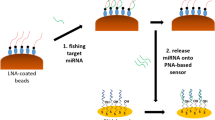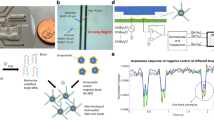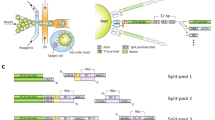Abstract
This review outlines the possibilities of magnetic separation techniques and the application of magnetic beads in bioassays. By linking monoclonal antibodies or DNA to magnetic beads, or by using magnetic beads coated with streptavidin, a specific interaction with the corresponding target is ensured. By means of an external magnet, the recovery of material for further studies is greatly simplified. Magnetic beads have proven valuable in cell separations, for example, removal of tumor cells from bone marrow and isolation of lymphoid cells from peripheral blood, and for the isolation, identification and genetic analysis of specific nucleic acid sequences (DNA or RNA) and for isolation of DNA binding proteins. In addition, some of these techniques have also proven to be useful in the detection of specific nucleic acids from viruses or bacteria.
This is a preview of subscription content, access via your institution
Access options
Subscribe to this journal
Receive 12 print issues and online access
$209.00 per year
only $17.42 per issue
Buy this article
- Purchase on Springer Link
- Instant access to full article PDF
Prices may be subject to local taxes which are calculated during checkout
Similar content being viewed by others
References
Guesdon, J.L. and Avrameas, S. 1977. Magnetic solid phase enzyme-immunoassay. Immunochemistry 14: 443–447.
Forrest, G.C. and Landon, J.R. 1978. Fully automated continuous-flow radioimmunoassay system employing magnetisable particles, p. 567–594. In: Automated immuno-analysis, vol. 2 (R. F. Richie) (Ed.) Dekker, New York.
Mosbach, K. and Schroder, U. 1979. Preparation and application of magneticpolymers for targeting drugs. FEBS Lett. 102: 112–116.
Schroder, U.L. and Mosbach, K. 1983. Magnetic particles for intravascularadministration: comprising magnetic material in carbohydrate matrix. Patent Cooperation Treaty Int. Appl, W083 91738.
Kronick, P.L., Campbell, G. and Joseph, K. 1978. Magnetic microspheresprepared by redox polymerisation: use as a cell separator based on gangliosides. Science 200: 1074–1076.
Margel, S., Zisblatt, S. and Rembaum, A. 1979. Polyglutaraldehyde: A newreagent for coupling proteins to microspheres and for labelling cell surfacereceptors. II. Simplified labelling method by means of non-magnetic and magnetic polyglutaraldehyde microspheres. J. Immunol. Meth. 28: 341–353.
Rembaum, A., Yen, R.C.K., Kempner, D. and Uglestad, J. 1982. Cell labelingand magnetic separation by means of immunoreagents based on polyacroleinmicrospheres. J. Immunol. Meth. 52: 341–351.
Ugelstad, J., Mørk, P.C., Kaggerud, K.H., Ellingsen, T. and Berge, A. 1980. Swelling of oiigomer-polymer particles. New methods of preparation of emulsion and polymer dispersions. Adv. Colloid Interface Sci. 13: 101–140.
Ugelstad, J., Kaggerud, K.H., Hansen, F.K. and Berge, A. 1979. Absorptionof low molecular weigth compounds in aqueous dispersions of polymer-oligo-mer particles. A two step swelling process of polymer particles giving anenormous increase in absorption capacity. Macromolec. Chem. 180: 737–744.
Ugelstad, J., Ellingsen, T., Berge, A. and Helg, B. 1983. PCT Int. Appl. WO 83/03920.
Boyum, A. 1986. Isolation of mononuclear cells and granulocytes from humanblood. Scand. J. Clin. Lab. Invest. 21 (Suppl. 97): 77.
Renzi, P. and Ginns, L.C. 1987. Analysis of T cell subset in normal adults. J. Immunol. Methods 98: 53–56.
Pellegrino, M.A., Ferrone, S. and Theophilopoulos, A.N. 1976. Isolation ofhuman T and B lymphocytes by rosette formation with 2-aminoethylisothiouro-nium bromide (AET)-treated sheep red blood cells and with monky red bloodcells. J. Immunol. Methods 11: 273–279.
Vartdal, F., Gaudernack, G., Funderud, S., Bratlie, A., Lea, T., Ugelstad, J. and Thorsby, E. 1986. HLA class I and II typing using cells positively selectedfrom blood by immunomagnetic isolation—a fast and reliable technique. Tissue Antigens 28: 301–312.
Brinchmann, J.E., Vartdal, F., Gaudernack, G., Markussen, G., Funderud, S.J. and Thorsby, E. 1988. Direct immunomagnetic quantification of lymphocyte subsets in blood. Clin. Exp. Immunol. 71: 182–186.
Funderud, S., Nustad, K., Lea, T., Vartdal, P., Gaudernack, G., Stenstad, P. and Ugelstad, J. 1987. Fractionation of lymphocytes by immunomagnetic beads, p. 55–65. In: Lymphocytes: A Practical Approach. G. G. B. Klaus (Ed.). IRL Press Ltd, Oxford, UK.
Lea, T., Vartdal, F., Nustad, K., Funderud, S., Berge, A., Ellingsen, T.R., Stenstad, P. and Ugelstad, J. 1988. Monosized, magnetic polymerparticles: Their use in separation of cell and subcellular components, and in thestudy of lymphocyte function in vitro. J. Mol. Recognition, 1: 9–13.
Hansen, T. and Hannestad, K. 1987. Simple rosette assay for HLA-B27 typing of whole blood samples. Tissue Antigens 30: 198–203.
Treleaven, J.G., Gibson, F.M., Ugelstad, J., Rembaum, A., Philips, T., Caine, D. and Kemshead, J.T. 1984. Removal of neuroblastoma cells from bonemarrow with monoclonal antibodies conjugated to magnetic microspheres. Lancet 14: 70–73.
Kemshead, J.T., Treleaven, J.G., Gibson, F., Ugelstad, J., Rembaum, A. and Philip, T. 1985. Monoclonal antibodies and magnetic microspheres used for the depletion of malignant cells from bone marrow, p. 413–423. In: Advances in Neuroblastoma Research Vol. 175. EvansA. E., D'Angio, J. and Seeger, R. C. (Eds.). A. R. Liss lnc., NY.
Kvalheim, G., Fodstad, Ø., Nustad, K., Pihl, A. and Funderud, S. 1985. Use of monodisperse, magnetic particles for removal of B-lymphoma cells from humanbone marrow. British J. of Cancer. 52: 652.
Kvalheim, G., Fodstad, Ø., Pihl, A., Nustad, K., Pharo, A., Ugelstad, J. and Funderud, S. 1987. Elimination of B-lymphoma cells from human bone marrow:Model experiments using monodisperse magnetic particles coated with primarymonoclonal antibodies. Cancer Res. 47: 846–851.
Bast, R.C., DeFabritiis, P., Lipton, J., Gelber, R., Maver, C., Nadler, L., Sallan, S. and Ritz, J. 1985. Elimination of malignant clonogenic cells from human bone marrow using multiple monoclonal antibodies and complement. Cancer Res. 45: 499–503.
Lea, T., Vartdal, F., Davies, C. and Ugelstad, J. 1985. Magnetic monosizedpolymer particles for last and specific fractionation of human mononuclearcells. Scan. J. Immunol. 22: 207–216.
Platsoucas, C.D., Chae, F.H., Kernan, N. et al. 1987. The use of magneticmonosized polymer particles for the removal of T cells from bone marrow cellsuspensions, p. 366. In: Microspheres: Medical and Biological Applications. A. Rembaum (Ed.). CRC Press, Boca Raton, PL.
Vartdal, F., Kvalheim, G., Lea, T., Bosnes, V., Gaudernack, G., Ugelstad, J. and Albrechtsen, D. 1987. Depletion of T-lymphocytes from human bone marrow. Use of magnetic monosized polymer microspheres coated with T-lympho-cyte-specific monoclonal antibodies. Transplantion 43: 366–371.
Johansen, L., Nustad, K., Berg Ørstavik, T., Ugelstad, J., Berge, A., and Ellingsen, T. 1983. Excess Ab immunoassay for rat glandular kallikrein. Mono-sized polymer particles as the prefered solid phase material. J. Immunological Methods. 59: 255–264.
Millan, J.L., Nustad, K. and Nørgaard-Pedersen, B. 1985. Highly sensitivesolid-phase immunoenzymometric assay for placenta! and monodisperse polymer particles. Clin. Chem. 31: 54–59.
Johne, B. and Jarp, J. 1988. A rapid assay for protein-A in Staphyhcoccus aureusstrains using immunomagnetic monosized polymer particles. Acta Pathol. Microbiol. Immunol. Scand. 96: 43–49.
Lund, V., Hellemann, A.L. and Vartdal, F. 1988. Rapid isolation of K88 + Escherichia coli by using immunomagnetic particles. J. Clin. Microbiol. 26: 2572–2575.
Skjerve, E., Rorvik, L.M. and Olsvik, O. 1990. Detection of Listeria monocytogenes in food by immunomagnetic separation. Applied and Environmental Microbiol. 56: 3478–3481.
Albretsen, C., Kalland, K.-H., Haukanes, B.-L., Håvarstein, L.-S. and Kleppe, K. 1990. Applications of magnetic beads with covalently attached oligonucleotidesin hybridization: Isolation and detection of specific measles virus mRNA from acrude cell lysate. Anal. Biochem. 18: 40–50.
Lund, V., Schmid, R., Rickwood, D. and Homes, E. 1988. Assessment ofmethods for covalent binding of nucleic acids to magnetic beads, Dynabeads™,and the characteristics of the bound nucleic acids in hybridization reactions. Nucl. Acids Res. 16: 10861–10880.
Jacobsen, K.S., Breivold, E. and Homes, E. 1990. Purification of mRNA directly from crude plant tissues in 15 min using magnetic oligo dT micro-spheres. Nucl. Acids Res. 18: 3669.
Hultman, T., Stahl, S., Homes, E. and Uhlen, M. 1989. Direct solid phasesequencing of genomic and plasmid DNA using magnetic beads as solid support. Nucl. Acids Res. 17: 4937–4946.
Gabrielsen, O.S., Homes, E., Korsnes, L., Ruet, A. and Oyen, B. 1989. Magnetic DNA affinity purification of yeast transcription factor (tau)—a newpurification principle for the ultrarapid isolation of near homogenous factor. Nucl. Acids Res. 17: 6253–6267.
Sproat, B.S. and Brown, D.M. 1985. A new linkage for solid phase synthesis ofoligonucleotides. Nucl. Acids Res. 13: 2979–2987.
Hultman, T., Bergh, S., Moks, T. and Uhlen, M. 1991. Bidirectional solid-phase sequencing of in vitro-amplified plasmid DNA. Bio/Techniques 10: 84–93.
Author information
Authors and Affiliations
Rights and permissions
About this article
Cite this article
Haukanes, BI., Kvam, C. Application of Magnetic Beads in Bioassays. Nat Biotechnol 11, 60–63 (1993). https://doi.org/10.1038/nbt0193-60
Issue Date:
DOI: https://doi.org/10.1038/nbt0193-60
This article is cited by
-
Evaluating and forecasting movement patterns of magnetically driven microbeads in complex geometries
Scientific Reports (2020)
-
Rapid and sensitive detection of HIV-1 p24 antigen by immunomagnetic separation coupled with catalytic fluorescent immunoassay
Analytical and Bioanalytical Chemistry (2016)
-
Non-stochastic sampling error in quantal analyses for Campylobacter species on poultry products
Analytical and Bioanalytical Chemistry (2013)
-
On the direct employment of dipolar particle interaction in microfluidic systems
Microfluidics and Nanofluidics (2012)
-
Magnetic trap effects on nanowire’s dynamics within micro-capillary vessels
Microfluidics and Nanofluidics (2011)



